Fox Meadow Claims Narrow Victory in Junior Olympics 2022
- Details
- Written by Adam Katcher
- Hits: 1656
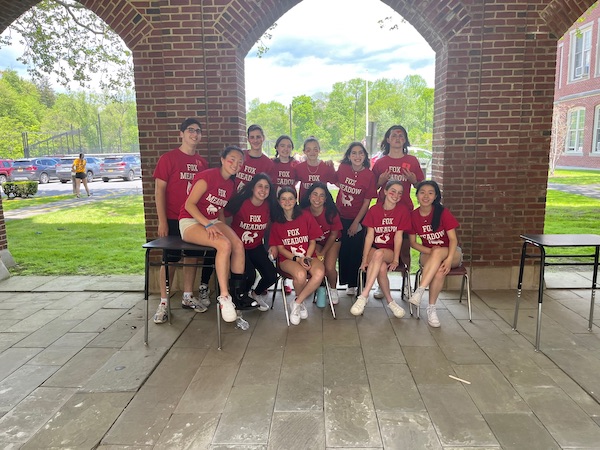 With the senior class out of the high school for Senior Options, there is a new grade in charge: Juniors are filling up the senior parking lots and assuming their place as the most advanced students in the school with one event is on everyone’s mind…Junior Olympics.
With the senior class out of the high school for Senior Options, there is a new grade in charge: Juniors are filling up the senior parking lots and assuming their place as the most advanced students in the school with one event is on everyone’s mind…Junior Olympics.
Junior Olympics is a staple at Scarsdale High School. Typically held on a random day in May (a day which is usually easy to predict based on teacher schedules but subject to change depending on weather forecasts), juniors are excused from their classes for a day of spirit and competition. Students are split up into five nostalgic teams, reuniting with their fellow respective elementary school graduates to compete against the four other elementary-school-based teams.
The entire day draws awe from the younger grades. While they sit in their classes, outside their windows, on Dean Field, Butler Field, and everywhere in between, juniors are taking each other on in fun games. There are obstacle courses and some sporting events for people to compete in. However, these Olympics are far from just athletic.
One of the long-standing classics of the Junior Olympics is a trivia competition, where academic wit meets general knowledge. “Name-that-Tune” has also become a fan favorite, even with some of the teachers running the event admitting to having never heard some of the newest songs in question. “Minute to Win It” is another high-tension event where students take each other on in brief bizarre challenges, such as seeing how many Oreos can be moved from the forehead into the mouth while sitting on their hands in sixty seconds or trying to stack as many dice on a popsicle stick held by the mouth as possible.
For these events, the five teams are split up into smaller teams so that everyone has the opportunity to contribute to their team’s progress. Afterwards, the entire grade reunites to spectate and partake in Tug-of-War. Team captains combine to decide who the best representatives from their teams would be to battle it out against other teams in a competition of sheer strength. After every team has had the opportunity to prove their might, an enthralling, albeit slightly revolting, pie-eating contest takes place.
This year, after the day of sports, tasks, battles, and abnormal competitions on May 17, the team that accumulated the most points and won was Fox Meadow. 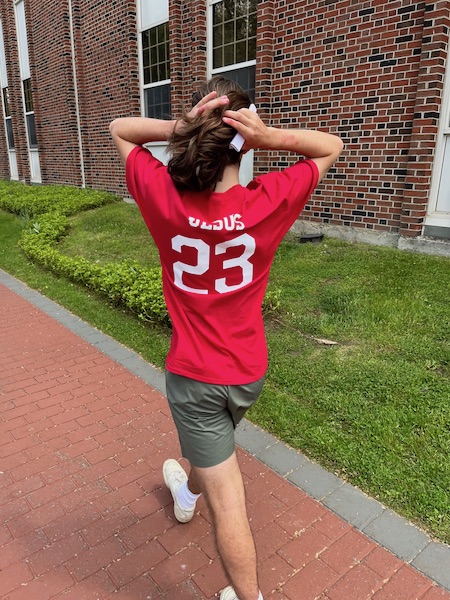 de la Fuente-Akersveen was one of four winning team captains
de la Fuente-Akersveen was one of four winning team captains
One of the winner’s captains, Oliver de la Fuente-Akersveen, was joyous about the positive outcome for his former elementary school classmates, saying, “It feels pretty great. It was nice to reconnect with kids I may not have seen since elementary school, and to represent our elementary school in fun games for a whole afternoon was a great way to spend a part of a day during a tough junior year. To win it, when we thought we had no chance, considering we lost Tug-of-War and the pie-eating, was pretty surprising and amazing.”
Fuente-Akersveen then discussed the comedy of seeing people trying to eat pie with no hands and getting their faces dirty, as well as the “Name-that-Tune” game’s competitiveness.
Other juniors said the day was “very anticipated and everyone was super excited when it was announced.” The special programming was a success and certainly met the juniors’ expectations. 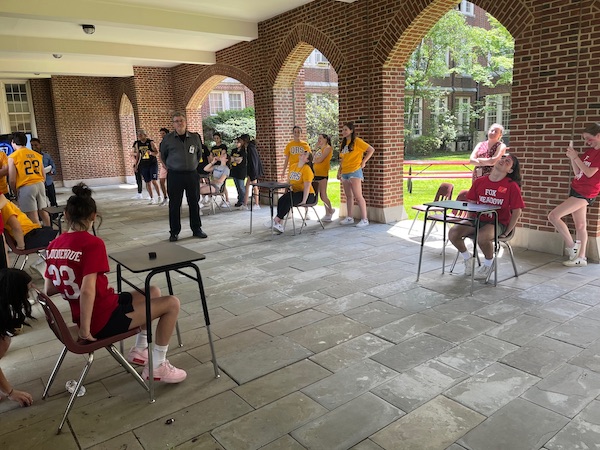 Minute to Win It saw bizarre skills on display
Minute to Win It saw bizarre skills on display
Fuente-Akersveen described the true meaning of the Junior Olympics perfectly. “Although everyone was divided by school, we were still all united in fun and as a community.”
Dr. Andrew Patrick Steps Into Role of Interim Superintendent and Confers Tenure to 10 Teachers and 2 Administrators
- Details
- Written by Joanne Wallenstein
- Hits: 1913
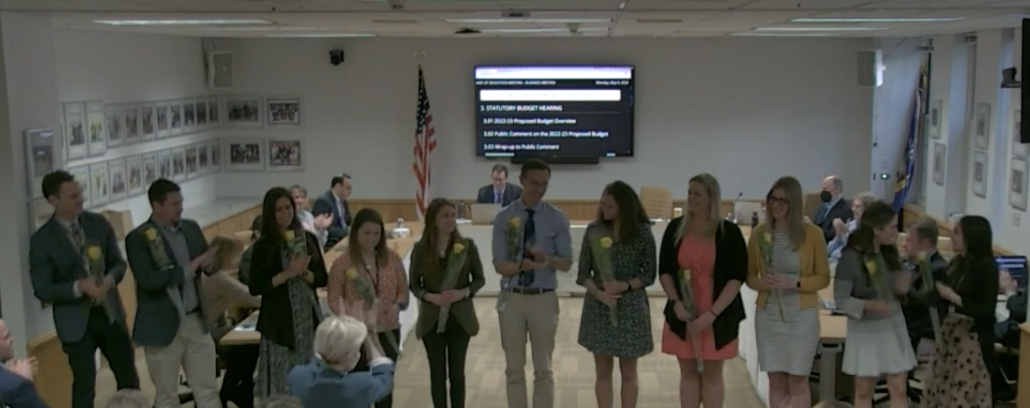 How fitting it was that May 9 was Interim Superintendent Andrew Patrick’s first meeting in his new role. Why? On Monday, the board conferred tenure to ten teachers and two administrators. In his role as Assistant Superintendent of Human Resources and Leadership Development, Patrick had championed them through the process of achieving this distinction. Patrick was speedily thrust into the leadership role when Scarsdale School Superintendent Thomas Hagerman suddenly vacated his position on Friday, May 5, 2022.
How fitting it was that May 9 was Interim Superintendent Andrew Patrick’s first meeting in his new role. Why? On Monday, the board conferred tenure to ten teachers and two administrators. In his role as Assistant Superintendent of Human Resources and Leadership Development, Patrick had championed them through the process of achieving this distinction. Patrick was speedily thrust into the leadership role when Scarsdale School Superintendent Thomas Hagerman suddenly vacated his position on Friday, May 5, 2022.
The previous week was also Teacher Appreciation Week and National School Nurse Day and Patrick took the opportunity to laud the entire staff.
Visibly pleased, he said, “Welcome honorees, there is a packed house tonight and it is excellent to see everyone." He continued, “I want to acknowledge the work of our teachers and nurses and colleagues. What you do, how you do it and why is noticed and deeply appreciated. Your work is essential to enabling the children in your care to reach for their full potential.”
He then discussed the ten teachers and two administrators who were recommended for tenure, saying, “It is significant accomplishment for the work of an educator…they complete a trial or probationary period of employment, a period of evaluation. We use the Charlotte Danielson framework which includes multiple observations by supervisors and evaluators, mentoring, a portfolio of artifacts, feedback from parents and children and an administrative review panel.”
He then read quotes from a few of the applicants:
In response to the question, “Why do you teach,” one wrote, “I teach because I believe there isn’t a more rewarding occupation when one can give children the confidence to become anything they desire. As a teacher I get to help children achieve their goals daily. Every day I have the chance to inspire a child and I do not take that opportunity lightly.”
And another applicant answered, “How do you create a culture and climate for learning?” by discussing their experience during Covid. They said, “This year, my student’s happiness was my motivation. Faced with a pandemic, students were asked to navigate technology and rely on executive functioning skills that are still developing. All of this while mourning the loss of peer interactions and grappling with increasing academic demands. I attempted to be a constant for those students who I have worked with over the past three years. I found that in order to do this, I needed to not only show up, but also rise up. I greeted all of my students at their classrooms to make a connection. I made sure they could see my smile, hear my laugh and feel success. Even on the darkest days they needed to feel seen and heard. That meant making time for check ins and small talks in our sessions. It meant reaching out to families and hearing what was needed at home. It meant making students feel that behind the mask there were people rooting for them here at school.”
The following teachers and administrators were recommended for tenure and the Board passed a resolution to grant it. Each staffer was given a rose, and after tenure was conferred, Dr. Patrick left the dais to go out into the audience to shake hands with each of the newly tenured staffers.
They are:
Jennifer Giustino, Edgewood Music
Jill Rappaport, Remedial Speech
Christin Palladino, Quaker Ridge Special Education
Shannon Smith, Quaker Ridge Special Education
Kaitlin Nolan, Quaker Ridge, Edgewood Physical Education
Talya Holtzer, Scarsdale Middle School Science
Benjamin Turner, Scarsdale Middle School Science
Kimberly Summerfield, Scarsdale High School English
Meredith Dutra, Scarsdale High School Special Education
Shoshana Gliksman, School Psychologist
Chris Welch, Assistant Principal at SHS
Dr. Edgar McIntosh, Assistant Superintendent for Curriculum, Instruction, and Assessment.
Board President Karen Ceske then welcomed Patrick in his new position as Interim Superintendent. She cited his “excellent credentials, leadership expertise, interpersonal skills, understanding of our work and the culture and values of our schools, and his true passion for education.” She said, “You are already familiar with so many members of our school community. We want to express the great confidence we have that you will provide leadership and continuity in the months to come. We recognize that a change in leaderships is significant and the board is committed to supporting you in this transition.”
School Budget
Ceske then turned to financial matters and assured the community that the outstanding IRS issue would not affect the proposed school budget which will be voted on May 17, 2022.
She explained that the Board held a meeting with their external auditors who ”provided an overview of how the IRS penalties and tax payments impact the district’s financial statements, proposed budget, and fund balance and confirmed that the IRS matter does not affect the tax rate, the tax cap, or the educational program proposed for our students in the 2022-2023 budget.”
IRS Matter
Ceske provided the following update on the status of the district’s abatement appeals to the IRS:
Tax counsel has provided the following update on the Q2 2021 matter: The Revenue Officer confirmed that the District’s request for abatement of the Q2 2021 penalty has been assigned to the appropriate representative in their office and is making its way through the stages of the review process. In addition, the Revenue Officer confirmed that their request to hold any determination on the lien action until a determination on the penalty abatement request has been granted. The Revenue Officer has requested from the appropriate representative a resolution on the penalty abatement request within 30 days and told the District’s tax attorneys to follow up with her after Memorial Day if they do not hear from her earlier.
Tax counsel has provided the following update on the Q3 2021 matter: The same Revenue Officer confirmed receipt of the District’s tax attorneys’ letter bringing to her attention the Q3 2021 matter and enclosing both the IRS Notice and the District’s response regarding the same. Because the response was not submitted directly to the Revenue Officer, she was unable to confirm at this time the status of the processing of the response and, more importantly, the Form 941 Schedule B for Q3 2021.
However, the Revenue Officer offered to conduct some research and see if she could locate the District’s response and request that the enclosed Form 941 Schedule B for Q3 2021 be processed as soon as possible. Again, the Revenue Officer told the District’s tax attorneys to follow up with her after Memorial Day if they do not hear from her earlier.
In addition, both the Revenue Officer and the District’s tax attorneys have again recommended that the District begin e-filing its Forms 941 and the District is and has been looking into options regarding the same.
Tax counsel has provided the following update on the Q4 2020 matter: The same Revenue Officer noted that the District’s account for Q4 2020 still showed a balance of what the Revenue Officer presumed to be the remaining penalties and interest. The Revenue Officer was not privy to any information other than that and, as such, could not expand upon the same. Recall, though, that the Appeals Officer indicated that her final request and approval for penalty abatement would take approximately two to three weeks to process, and we have not yet exhausted that timeframe. Tax counsel will continue to follow up with the Appeals Officer on a regular basis.
She said, “Please know that the Board will provide further updates to the community as we continue to work on this matter and the investigation into it.”
Meeting with High School Students
Ceske reported on a meeting the Board held earlier in the evening with representative students from the high school where they discussed “moving forward after the pandemic.” She said, the students “said their teachers have brought them to a good place and engaged them and that they continue to use technology such as Google Classroom to help them with organization. They talked about how great it is to have spaces reopen and that they are engaged in activities that promote community.”
She continued, “We spoke about creating a sense of wellness here at SHS. They talked about how important the little things are like supportive gestures from teachers, funny jokes, the therapy dogs that visit, and snacks. They spoke of the importance of resources like the library, the LRC and the math center and about the new mental health awareness club.” She thanked them for “openly sharing” their thoughts.
Public Comments
Art Rublin, Chair of the Coalition for Scarsdale Schools thanked the board for exceptionally hard work over the last few months. He offered congratulations to Dr. Patrick, saying, “We are appreciative that you are willing to do two jobs for the district at once. This is a new chapter of collaboration and communication and curriculum development for the Scarsdale schools. We are confident in your communication skills with the board and the faculty -- and this is after you had to negotiate two contracts with the teachers, so that speaks volumes.”
About Patrick, Rublin said, “He has a human touch with the faculty and we saw it tonight when he came from behind the dais to congratulate newly tenured faculty. He will be dedicated to robust communication with the community. He exudes accessibility…I am confident he will move forward on teaching and learning initiatives. So too will it be important for the community to engage with him. The Coalition for Scarsdale Schools will support the district budget and vote on Tuesday May 17 from 7 am to 9 pm.”
Mayra Krikendall Rodriguez said the following: “Pages 59-63 in the proposed 2022-23 budget documents which are almost 170 page are about the fund balance. The amount of the fund balance matters. It impacts budgets. As the District states on page 59, schools and other municipalities create a Fund Balance for example, 'when expenditures are less than revenues' as is the case in this proposed budget, and to be ready for uncertainties.
"So if we are starting with a lower fund balance in 2022-2023, this will influence what revenues and expenditures can be in coming years. This in itself is a big and old challenge in Scarsdale. The District creates annual budgets without the context of long-term planning. I would get fired if I did not ask my clients to think of annual budgets in the context of long-term planning.
"As many residents have often stated, good communication and transparency with residents is important. It would be good to know when exactly were internal auditors, external auditors and the District’s lawyers first made aware of the penalty and lien issues? 2020, 2021, or this year? Were they completely unaware of what was going on? If they had known, then it is time to clean house.
"In early April, the District said that it would book the penalties as a receivable and that auditors had said this was acceptable. Please let us know which auditor told you it was okay to book an expense as a receivable? Was it the external or internal auditor? Do you need independent verification that this is acceptable under GASB 34?
"Also at the May 5th, the External auditors repeatedly said they were meeting with management? With whom precisely? Are there conflicts of interest if External Auditors are speaking to management which means the Administration, some of whom may be under investigation by Brock. It is difficult to know since key parts of the contract are redacted.
"Out of curiosity, why did the Board of Education have a meeting with External auditors without allowing any public comment? We have all kinds of accounting, auditor and finance professionals in town. You could have really benefitted from being transparent and inclusive of the great diversity of skills and expertise we have in Scarsdale.”
Bob Berg of 17 Black Birch Lane called in from an interstate in Western Montana. He said, “I am concerned about a cover up of the cover up. Who authorized the tax payment as an account receivable? This has not been answered. The Board agreed not to approve the internal auditors to do the review. Is the NYS Comptroller doing an investigation of what went on here? I think the public wants the answers.
Internal Audit
The board had a lengthy discussion about a resolution to hire internal auditors Cullen and Danowski to review the district’s payroll processing procedures in the wake of the mistakes in filing that led to the IRS penalties, fines and a lien. The discussion centered around retraining the current firm to do the audit, versus hiring a new firm to take a second look at district procedures. The existing firm could begin the work right away, while it would be necessary to post an RFP to get a new firm, and the process would take longer.
Carl Finger said, “I support an audit. In past years they did not audit the payroll process so this is an important first step toward preventing anything from happening in the future.”
James Dugan said, “I have no reason to believe Cullen and Danowski LLP missed something. My concern is that through the passage of time auditors get too comfortable with the clients they are auditing and don’t look with a clean set of eyes. This is simply a best practice. Companies switch auditors every few years simply for that reason. I would be more comfortable securing another firm to do this work."
Ron Schulhof said, “This internal audit is important – I would lean toward bringing in a third-party auditing firm for this project. There are other firms that are familiar with Westchester.”
Assistant Superintendent Stuart Mattey added, “We would need to do an RFP and wait for proposals. It would probably take three weeks. Cullin and Danowski would send Don (the principal of the firm)."
Jessica Resnick-Ault said, “I am torn between having a third party auditor and being expedient. The thought of not getting the results until the end of the school year is a concern. Maybe we can rotate who we use as auditors in the future. But if we do hire them, let’s ask them to expedite the process.”
Bob Klein said, “Because of the limited scope of the investigation, my bias is to expedite this as quickly as possible. I would like it done in a week using this group and then we can revisit who is doing what for the long term. If we can expedite an oral presentation of findings before a formal report, it would be helpful.”
Amber Yusuf said, “I would like this done as quickly as possible using this firm. A new firm would not be done until the end of July. Let’s use Cullen and Danowski now and put out an RFP for another firm for the future."
Stuart Mattey added, “This audit will help us identify things we can do better. Give us the best practices.”
Karen Ceske said, “I struggle with why we would not wait and put in someone new when we’re not even sure we can get the report before June 30.”
After considerable back and forth, the Board ultimately voted down the motion to hire Cullen and Danowski. The board will look for other options and asked Mattey to draft an RFP to other auditing firms to do an auditing of the payroll process as soon as possible.
Paulin Advocates to Bring Attention to New York’s High Rate of C-Sections
- Details
- Written by Joanne Wallenstein
- Hits: 1458
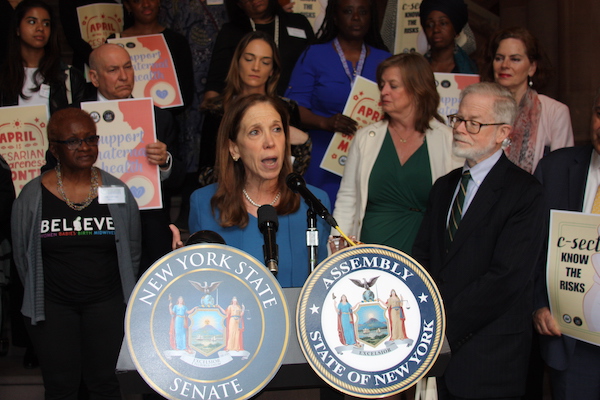
With New York State’s c-section delivery rate at 32%, one of the highest in the nation and significantly above the CDC and World Health Organization ideal range of 10-15%, Assemblymember Paulin and Senator Salazar’s Informed C-section Bill (A217/S2736) is critical to helping women in New York State. There are serious potential consequences from c-section deliveries. Studies have found that cesarian birth rates are directly linked to higher maternal death rates.
April is C-Section Awareness Month, and earlier this month the Department of Health released a Report on Pregnancy-Associated Deaths in New York State which further highlights the link between c-sections and maternal mortality. The report found that there were 41 pregnancy-related deaths in 2018, with hemorrhage and embolism as the two leading causes. The report determined that of the pregnancy-related deaths caused by hemorrhage, all of them were preventable. The report’s findings demonstrate the critical need to reduce the rate of cesarean births, especially for women of color who are four times more likely to die of pregnancy-related deaths than other women.
C-sections also pose additional risks such as ruptured uterus, unplanned hysterectomy, and blood transfusions, which may seriously affect a women’s future health and their ability to have more children.
“It’s imperative that women are informed of the risks, both immediate and in the future, of c-sections,” said Assemblymember Amy Paulin. “While there are scenarios where a cesarean delivery is the safest option, C-sections can pose immediate risks for the mother and baby, and can have negative consequences for women who want to continue to grow their families. We must educate expecting mothers, ensure informed consent for c-sections, and train providers to develop knowledge and skills on approaches that will maximize the likelihood of vaginal birth. New York State can improve the maternal mortality rate and women’s maternal health by taking direct actions to reduce the cesarean birth rate and improve the quality of care that expectant mothers receive — which the bills State Senator Salazar and I have proposed seek to achieve.”
"As last year's Chair of the Women's Issues Committee and a member this year, I know all too well, how necessary the C-section Awareness Month Legislative Package bills are to the 4.3 million women living in New York,” said State Senator Julia Salazar. “This isn't a matter of convenience, it’s a matter of necessity. Our mission is and should continue to improve maternal-child health by reducing preventable cesareans through thoughtful legislation as well as public education. It is well documented that maternal and child health are improved by preventing unnecessary cesareans. We owe it to the countless mothers of New York to have the best informed options at the ready when undergoing childbirth."
They also discussed the following c-section and maternal health-related bills which they seek to pass in the NYS Legislature during the current legislative session:
A9098a/S8751 (Paulin/Brouk) requires hospitals and birth centers to make information on maternity related proceduresavailable on the NYS Department of Health website for the most recent five years for which the data is available. Thiswill help maternity patients make the most informed decision when choosing where to give birth.
A9714a/S8866 (Paulin/Brouk) establishes a cesarean births review board comprised of experts in the field of maternalmortality, women’s health, and public health for the purpose of lowering cesarean birth rates and improving maternal health.
A8392/S3010 (Paulin/Ramos) provides an insurance premium reduction to physicians and licensed midwives whocomplete a risk management strategies course in obstetrics or midwifery. The skills taught in these courses will seek to improve maternal safety, birth outcomes and promote informed consultations from the prenatal through postpartum periods.
A8536/S7628 (Gottfried/Salazar) adds a women's health care provider to the New York State Public Health & Health Planning Council (PHHPC). As the PHHPC reviews applications for health care facilities like birthing centers andreproductive health care clinics, it is essential to have a member that represents providers of women’s health care services.
Many advocates, Assemblymembers and State Senators joined the rally in support.
Helena Grant, New York Midwives President and Director of Midwifery at Woodhall Hospital said “New York Midwives proudly stand with Assemblymembers Paulin and Gottfried and Senators Salazar, Brouk, Ramos, and their colleagues to strongly support legislation to ensure that the birthing people of this great state have transparent information and are empowered to make health care choices grounded in self-advocacy and wellness. Cesarean birth rates and the associated maternal mortality and morbidity related to increased bleeding, infection, longer healing time, and placental implantation issues with subsequent surgical births are too high in NYS and disproportionately affect Black women. Hospitals with practicing midwives have lower rates of cesarean births. A healthcare system that allows medical providers to choose not to offer vaginal births after cesarean births to birthing people who are good candidates deserve further discourse. Hospitals with practicing midwives have higher VBAC rates. Risk management strategies, such as simulation and debriefing training, are essential to ensure health equity and procedural quality. An insurance premium reduction would be beneficial to those who complete such training as they continue to accept the calling to serve the birthing families of NYS at a time when the number of obstetric and primary care providers in the state has decreased. Adding the voice of women’s health care providers to PHHPC would ensure that the care needs of 50% of the population experiencing menarche, birth, menopause, and beyond would be heard and advocated for. Expertise in women’s health issues is vital and must be welcomed to the table. New York Midwives recognize that these bills are rooted in reproductive justice, birth equity, erasing health disparities, ending maternal and infant morbidity and mortality, the prevention of trauma, and the uplifting of the shared-decision making model rooted in Midwifery care. We are proud to stand with and be represented by legislators that are bold enough to create bills that have the power to shift the trajectory of the conversations we are having with one another as healthcare providers and with the clients we serve because they believe that the women of NYS deserve birth experiences that are safe, satisfying, and sacred.”
State Senator Cordell Cleare said, “As Chair of the Senate Standing Committee on Women’s Issues, I am a proud and vocal co-sponsor of every single bill in the C-Section Awareness Month Legislative Package. I will make it my core mission to ensure that we pass the whole package this year and begin to empower mothers, educate patients and reverse the long history of health disparities disproportionately affecting black women.”
“I’m proud to have passed S3010 through the Senate, which provides incentives and support for licensed midwives who complete a risk management strategies course. Equipping practitioners and community-based health providers with all the tools they need to help their patients through critical reproductive health decisions is how we get at the root of racial disparities in maternal health and mortality. With Assembly Member Paulin’s leadership on this issue, this bill, and a full package of legislation directed at improving c-section best practices, will move through the Assembly and to the Governor’s desk,” said State Senator Jessica Ramos (D, WF - SD13)
State Senator Samra Brouk said “When doctors recommend a c-section during active labor, the birthing parent often has little to no time to review data or make an informed decision. That’s why I’m proud to sponsor legislation with Assemblymember Amy Paulin to require hospitals and birthing centers to make information available on their c-section practices, as well as legislation that creates a cesarean births review board to lower cesarean birth rates and improve maternal health. Healthy mothers mean we have healthy babies, healthy families, and healthy communities. We must prioritize meaningful system change to improve the health outcomes for expecting parents of all racial and ethnic backgrounds.”
Assemblymember Michaelle Solage said “Birthing parents should have access to full and complete information on the risks and benefits of a vaginal birth and a cesarean section in order to make informed choices about their healthcare. While a cesarean can be lifesaving for a mother and her baby in certain circumstances, maternal and child health are improved by preventing unnecessary cesareans which can lead to tragic health outcomes, primarily impacting women of color.”
"New York's high prevalence of C-sections, especially among minority populations, has dangerous, avoidable consequences for mothers and babies," said Assembly Health Committee Chair Richard Gottfried. "This bill package will ensure that health care facilities, practitioners, and State policymakers are responsive to the needs of pregnant patients and that patients have appropriate knowledge and protection when deciding how to deliver their babies.”
Jerika Richardson to Speak on Voting Rights at LWVS Luncheon Friday May 6
- Details
- Written by Joanne Wallenstein
- Hits: 961
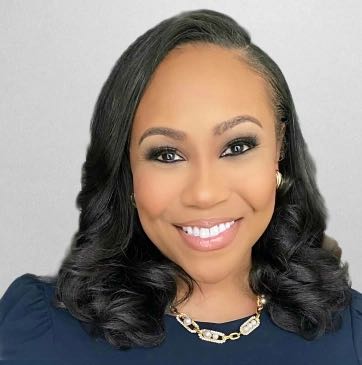 LWVS Luncheon: The Future of Voting Rights: Current Battles and Where We Go from Here with Jerika L. Richardson
LWVS Luncheon: The Future of Voting Rights: Current Battles and Where We Go from Here with Jerika L. Richardson
The community is invited to the LWVS Luncheon at Scarsdale Golf Club at noon on Friday May 6, 2022. Speaker Jerika L. Richardson is Senior Vice President for Equitable Justice and Strategic Initiatives at the National Urban League. She leads the organization’s advocacy, public education, and strategic work on civic engagement, police reform, criminal justice reform, and other justice related areas. Previously, Ms. Richardson was Deputy Executive Director and the Senior Advisor & Secretary to the Board for the nation’s largest independent police oversight agency, the New York City Civilian Complaint Review Board.
She has also served as Chief of Staff in the Office of the Counsel to the Mayor of New York City and Special Advisor to the Mayor for media relations, criminal justice, and public safety planning. Before working in City Hall, Ms. Richardson was the Senior Spokesperson for the U.S. Attorney’s Office in the Southern District of New York and a Field Producer & Off-Air Reporter for ABC News. She holds a J.D. from the University of Michigan Law School and a B.A. in English from Spelman College.
Click here to purchase tickets:
LWVS Annual Meeting and Spring Luncheon
Friday, May 6, 2022
10:45 am to 2 pm at Scarsdale Golf Club (Speaker and lunch 12 noon)
Recognizing the Unique Homes that Characterize Scarsdale
- Details
- Written by Joanne Wallenstein
- Hits: 1709
 (This is the opinion of Scarsdale10583 founder Joanne Wallenstein)
(This is the opinion of Scarsdale10583 founder Joanne Wallenstein)
A recent trip to Charleston, SC gave me a new perspective on Scarsdale’s struggle to preserve our past. Spring was in full bloom with fragrant wisteria, colorful azaleas and stunning magnolias, and residents welcomed visitors to their gardens and inside their centuries-old homes during a three week period of tours arranged by the Historic Charleston Foundation. You couldn’t help but notice the pride and enthusiasm of the homeowners and volunteers as they guided us through verdant gardens and 19th century houses that had been updated with every modern convenience.
The historic district is lined with brick and clapboard homes, most with inviting porches, each unique but in concert with its neighbors. Walking the streets, peering through wrought iron gates, down alleys, and into secret gardens is intoxicating.
Many of the homes offer a narrative about their history on signage outside. There were small gold plaques marking the year the homes were built and the names of the original owners. Some had larger signs with multiple paragraphs about the provenance of the house, the architects, and the names and occupations of the owners.
As one of the preservationists on the tour told me, “These current homeowners consider themselves to be caretakers of these houses for now and future generations. They value what they have and know its worth preserving. No one would think of taking down one of these homes.”
I couldn’t help but compare this ethos to Scarsdale, where rather than seek to preserve their houses, many fight to demolish the stately homes that characterize the Village and our history. They subvert our laws, contend that the homes are worthless, and when they don’t get what they want, they sue the Village.
Why not turn this energy toward preserving what originally attracted many of these people to Scarsdale? Is there a way to build pride in our historic homes, 49% of which were built before 1940? How can we celebrate the unique architecture that characterizes the ‘Dale and laud residents who renovate instead of raze? In other words, how can we make it cool to live in and protect your old house?
The Village took the first step in preserving Scarsdale in 2012, when they hired architectural historians to survey our homes. In their introduction they say, “What is so astounding about Scarsdale is the quality of the housing no matter what the scale of the dwelling or the income-level of the original residents. There are wonderful homes of substantial scale in Fox Meadow and Murray Hill, but there are also smaller, yet still extraordinary homes in East Scarsdale and in the Scarsdale Heights area of Greenacres. A few of these houses were designed by well-known architects, but most, no less interesting and distinguished, are the work of little-known, often local Westchester designers.”
“While certain styles dominate the built landscape of Scarsdale, notably the Neo-Tudor, the English Cottage, and the Colonial Revival, other styles are evident throughout the village, including buildings with designs derived from Mediterranean architecture, from the Italian Renaissance, and from French Norman design, and there are also a number of important examples of post-World War II Modernism. All of these styles were employed with great originality and ingenuity throughout the village.”
 They also noted that it is the individual homes, as well as the neighborhoods that warrant preservation. The report says, “When we consulted with representatives of the New York State Office of Historic Preservation, which manages the state’s National Register Program, they thought that many of the neighborhoods of Scarsdale would be eligible for National Register listing in their totality. Rather than taking such a broad-brush approach for a local survey, we looked for the very best and most cohesive areas. We also sought out clusters of buildings that reflected various eras of Scarsdale development.” The report outlines areas that might be denoted “historic districts.”
They also noted that it is the individual homes, as well as the neighborhoods that warrant preservation. The report says, “When we consulted with representatives of the New York State Office of Historic Preservation, which manages the state’s National Register Program, they thought that many of the neighborhoods of Scarsdale would be eligible for National Register listing in their totality. Rather than taking such a broad-brush approach for a local survey, we looked for the very best and most cohesive areas. We also sought out clusters of buildings that reflected various eras of Scarsdale development.” The report outlines areas that might be denoted “historic districts.”
Unfortunately the Village of Scarsdale did not follow through with the next steps which were to designate individual homes for historic designation and define historic districts, but the basis for this work remains in the report.
Clearly some limits need to be set. It’s been ten years and the Village has not been willing to impose laws to discourage avaricious developers who aggressively hunt down opportunities to replace existing homes with McMansions that don’t fit in with neighboring homes, price new families out of town, strain our infrastructure and crowd our streets. We’re experiencing flooding as our tree canopy is destroyed and our storm sewers can’t handle the additional output.
The irony is that some claim that it’s bad economics to impose preservation laws. But facts show otherwise. Homes in historic districts have enhanced value and buyers appreciate good craftsmanship and quality design. According to completecommunities.org, “Preserved structures add character and charm, enhance neighborhood pride, and fosters a strong cultural identity among generational residents.”
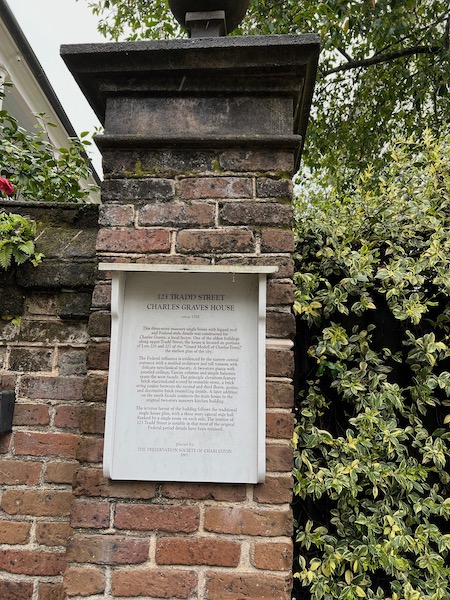 So what can we do to foster this sense of pride in historic Scarsdale homes?
So what can we do to foster this sense of pride in historic Scarsdale homes?
Here are a few ideas:
-Let’s recognize our older homes and treasure them. How about producing brass plates with the new Village logo, the year the house was built and wording to note its historic importance. Residents could purchase these with contributions going toward a preservation fund.
-Research on individual homes could be done and provided to the homeowners who purchase these plates. This research could be passed on with the home from owner to owner.
-An annual tour of historic homes could be done to showcase both historic properties and new renovations to historic homes. There are many good examples of old homes, redone to accommodate today’s lifestyles.
-Selling your home? With multiple offers and price wars resulting from the shortage of inventory, do what you can to sell your house to someone who wants to live in it rather than tear it down. Ask your realtor for ideas or even consider adding a covenant or legal language requiring the home to be preserved in the contract of sale. If developers are unable to scoop up homes, maybe they will seek to reap profits elsewhere.
 Perhaps you have other ideas on how we can enhance historic preservation in town. While we wait for the Village Trustees to address the matter, as residents we can do a lot to save what remains.
Perhaps you have other ideas on how we can enhance historic preservation in town. While we wait for the Village Trustees to address the matter, as residents we can do a lot to save what remains.
Want to help? Email me at scarsdalecomments@gmail.com.














